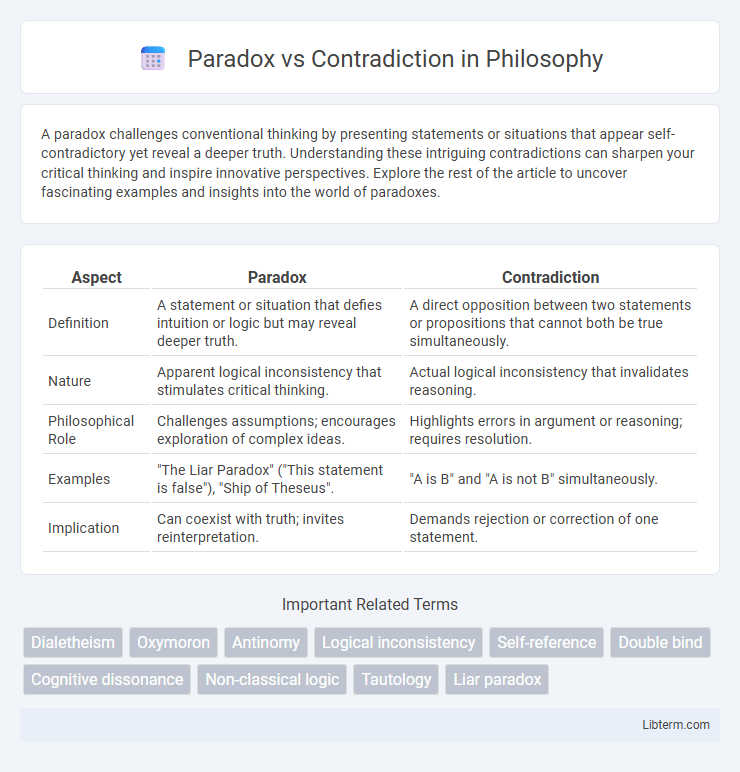A paradox challenges conventional thinking by presenting statements or situations that appear self-contradictory yet reveal a deeper truth. Understanding these intriguing contradictions can sharpen your critical thinking and inspire innovative perspectives. Explore the rest of the article to uncover fascinating examples and insights into the world of paradoxes.
Table of Comparison
| Aspect | Paradox | Contradiction |
|---|---|---|
| Definition | A statement or situation that defies intuition or logic but may reveal deeper truth. | A direct opposition between two statements or propositions that cannot both be true simultaneously. |
| Nature | Apparent logical inconsistency that stimulates critical thinking. | Actual logical inconsistency that invalidates reasoning. |
| Philosophical Role | Challenges assumptions; encourages exploration of complex ideas. | Highlights errors in argument or reasoning; requires resolution. |
| Examples | "The Liar Paradox" ("This statement is false"), "Ship of Theseus". | "A is B" and "A is not B" simultaneously. |
| Implication | Can coexist with truth; invites reinterpretation. | Demands rejection or correction of one statement. |
Understanding the Basics: What is a Paradox?
A paradox is a statement or situation that defies intuition by presenting two seemingly contradictory truths that coexist, challenging conventional logic and encouraging deeper analysis. It differs from a contradiction, where two statements cannot both be true simultaneously and must be resolved or rejected. Understanding paradoxes involves exploring complex concepts in philosophy, mathematics, and language that reveal hidden truths or highlight limitations in reasoning systems.
Defining Contradiction: Key Characteristics
Contradiction is defined by the presence of two or more statements or propositions that cannot be true simultaneously, exhibiting direct opposition in truth value. Key characteristics include mutual exclusivity, logical incompatibility, and the inability for the components to coexist without contradiction arising. This makes contradictions fundamental to identifying logical inconsistencies within arguments, theories, or systems.
Paradox vs Contradiction: Core Differences
Paradox and contradiction differ fundamentally in logic and meaning; a paradox presents a seemingly self-contradictory statement that reveals a deeper truth upon analysis, whereas a contradiction is an outright logical inconsistency that invalidates a statement. Paradoxes often provoke critical thinking by challenging assumptions, exemplified by the "liar paradox," while contradictions signify errors, such as asserting both "A" and "not A" simultaneously. Understanding the core difference helps clarify complex philosophical and mathematical problems by distinguishing meaningful paradoxes from genuine contradictions.
Semantic Origins and Linguistic Roots
Paradox and contradiction both stem from ancient Greek, with paradox deriving from paradoxos (paradoxos), meaning "contrary to expectation," and contradiction from contradictio, rooted in Latin contra ("against") and dico ("speak"). The semantic origins highlight paradox as an assertion that defies intuitive logic yet may hold truth, whereas contradiction denotes a direct opposition between statements, implying mutual exclusivity. Linguistically, paradox often conveys complexity and nuance in discourse, while contradiction signifies clear-cut logical inconsistency.
Examples of Paradoxes in Philosophy
Philosophical paradoxes often challenge logical norms by presenting situations that defy intuitive reasoning, such as Zeno's paradoxes, which question the nature of motion and infinity through puzzles like Achilles and the Tortoise. Another example is the Liar Paradox, exemplified by the statement "This sentence is false," which creates a loop of truth-value inconsistency. These paradoxes differ from contradictions because they expose deeper issues within concepts or language rather than simply presenting mutually exclusive statements.
Real-World Contradictions: Everyday Cases
Real-world contradictions often arise in scenarios where conflicting beliefs or actions coexist, such as the contradictory demands between work-life balance and career advancement. For example, a person may prioritize health but simultaneously engage in habits detrimental to well-being, highlighting an evident contradiction in behavior. These everyday contradictions challenge logical consistency and require nuanced understanding to resolve practical tensions.
The Role of Logic in Identifying Each
Logic plays a crucial role in distinguishing paradoxes from contradictions by analyzing the consistency and coherence of statements within a formal system. A paradox challenges intuition or common sense without necessarily violating logical principles, revealing complexities or hidden assumptions, while a contradiction directly violates the principle of non-contradiction, making the system logically inconsistent. Identifying paradoxes involves examining underlying premises and inference rules, whereas detecting contradictions relies on proof techniques that demonstrate mutually exclusive propositions cannot simultaneously hold true.
Why Paradoxes Matter in Critical Thinking
Paradoxes challenge conventional logic and highlight limitations in our understanding, making them essential in critical thinking. They force individuals to question assumptions, analyze underlying premises, and refine reasoning processes to resolve apparent contradictions. Engaging with paradoxes enhances cognitive flexibility, promoting deeper insights and innovative problem-solving skills.
Contradictions in Language and Communication
Contradictions in language and communication occur when statements or expressions convey mutually opposing meanings, creating confusion or ambiguity in interpretation. These contradictions can undermine effective dialogue by generating uncertainty about the speaker's intent or the factual accuracy of information. Understanding and identifying contradictions is crucial for clarity in discourse, enhancing both interpersonal communication and critical analysis.
Resolving Paradoxes and Contradictions: Approaches and Solutions
Resolving paradoxes and contradictions involves distinct approaches: paradoxes often require re-examining underlying assumptions or redefining concepts to reconcile seemingly true yet conflicting statements, while contradictions demand logical consistency checks to eliminate mutually exclusive claims. Techniques such as dialectical reasoning, formal logic analysis, and pragmatic contextualization are commonly employed to address paradoxes by uncovering hidden premises or alternative interpretations. Contradictions are typically resolved through falsification, clarification of terms, or reformulation of propositions to restore coherence within logical frameworks.
Paradox Infographic

 libterm.com
libterm.com